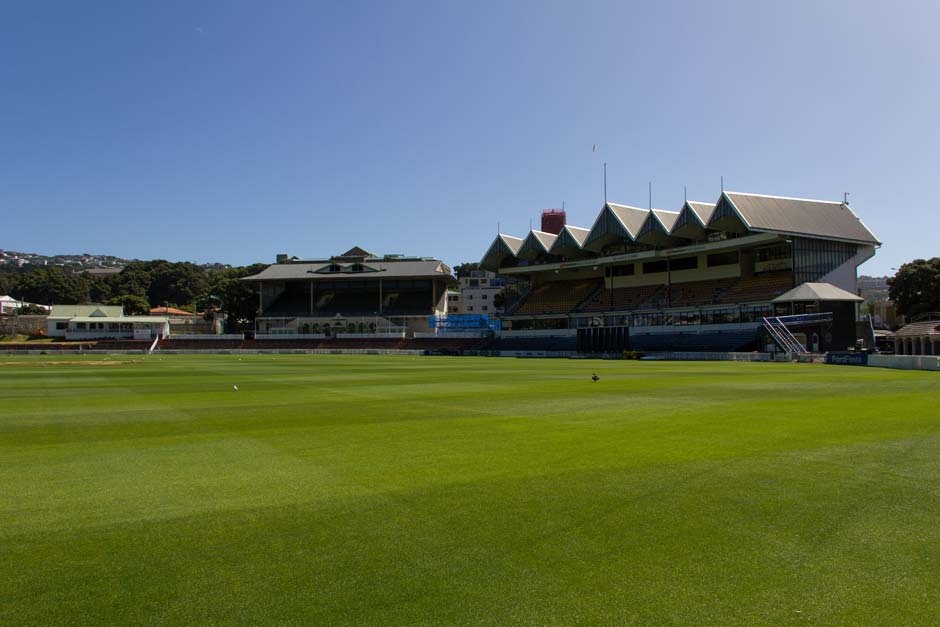
Basin Reserve (1863)
Cricket’s sacred ground
Why did surveyor William Mein Smith select this shallow swamp for a dock when Port Nicholson could cater for any ship likely to come here? But draw it in he did, making it the ‘Basin’, or Dock Reserve. The dock and canal running down Kent and Cambridge Terraces lurked on plans until uplift from the 1855 earthquake all but drained the reserve. Now its destiny lay as a recreation reserve. In 1863 prisoners added fill and three years later a citizens’ committee designated it a cricket ground. By 1868 there was a grandstand here and the Volunteers and a team from HMS Falcon had fought out the first match.
We think of this as a cricket ground but over the years it has also hosted hockey, rugby union, league, association football, cycling, rifle practice, band displays, dog racing, baseball, lacrosse, softball, open-air religious services, opera, jamborees, military displays and political and royal visits. Some have been unusual or noteworthy. In 1879 the first public display of electricity in the country took place here. Twenty years later Captain Lorraine, balloonist, ‘aeronaut’ and blow-hard, got blown away, literally. He took off successfully but the wind pushed the balloon south-east, forcing the self-styled ‘King of Parachutists’ to drop into Wellington College instead of the Basin Reserve, where the crowd was waiting for him. In 1913 some of the Buckle Street fencing was damaged during the waterfront strike. But since 1884 cricket has been top dog. Cricketers love statistics: by 1997 it had hosted 329 first-class and international matches, the country’s largest tally. Here, a plaque explains, Martin Crowe and Andrew Jones set a world record test partnership for any wicket against Sri Lanka. Now one of the country’s most significant grounds, the Basin was the first sports ground registered by the Historic Places Trust (now Heritage New Zealand).
There are several historic structures. The playing ‘oval’ (1863, although it was never that shape) was brought into the modern era in 1979-81 when the big R.A. Vance Stand appeared on the western boundary and the eastern bank was developed. Older buildings include the late 19th-century groundsman’s shed, the 1923 gates (later named the C.S. Dempster and J.R. Reid Gates after prominent cricketers) and the 1924 Museum Stand, which housed the New Zealand Cricket Museum.
One of the most intriguing structures is the memorial to Colonel William Wakefield, leader of the New Zealand Company’s Wellington settlement from 1840. When he died in 1848 friends raised money for a memorial but, like everything to do with the Company, it went awry. They finally ordered this little folly from a British foundry in 1862 but it lay in storage for 20 years before the council put it up inside the Basin Reserve. Here it stayed until 1917 when it was exiled to the side of the three-lane road which surrounds the grounds. Deemed beyond repair more than 40 years ago, it was fixed up and rededicated on a new site inside the grounds in 2006.
Historic it may be, but the Basin continues to evolve. In 2012 the Museum Stand was yellow-stickered after a negative earthquake assessment in the wake of the Canterbury 2010/11 quakes. Its future remains uncertain. Controversial plans for an expensive and intrusive flyover along its northern edge as part of improvements to this notorious traffic bottleneck suggest that more changes are on the way.
Further information
This site is item number 30 on the History of New Zealand in 100 Places list.
On the ground
The grounds contain several plaques in addition to the interpretation on the William Wakefield Memorial.
Websites
- Heritage New Zealand List - Basin Reserve Historic Area
- Heritage New Zealand List - Basin Reserve Pavilion
- Heritage New Zealand List - William Wakefield Memorial
- Te Ara image
- New Zealand Cricket Museum
- Cricket Wellington history
Book
- Don Neely and Joseph Romanos, The Basin: an illustrated history of the Basin Reserve, Canterbury University Press, Christchurch, 2003









Community contributions